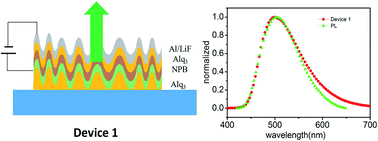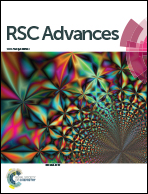Enhanced outcoupling efficiency and removal of the microcavity effect in top-emitting OLED by using a simple vapor treated corrugated film†
Abstract
We proposed a simple new method to form organic corrugated film. 50 nm tris(8-quinolinolato)aluminum film which was deposited on a glass substrate was put into an uncured ultraviolet (UV) adhesive atmosphere with active ingredient acrylate monomer. After 12 hours of treatment a corrugated film with nano grains was formed, the surface roughness was changed from 1.8 nm to 26 nm, which was caused by solvent-induced crystallization under the uncured UV adhesive atmosphere. We studied the film morphology, UV absorption and photoluminescence. The optical haze effect was also measured. By using the corrugated film in top emitting organic light-emitting diodes, the microcavity effect was eliminated, and the out-coupling efficiency was obviously improved, and the efficiency improvement was a result of the scattering of the surface plasma mode.



 Please wait while we load your content...
Please wait while we load your content...